engine FIAT STILO 2006 1.G Manual PDF
[x] Cancel search | Manufacturer: FIAT, Model Year: 2006, Model line: STILO, Model: FIAT STILO 2006 1.GPages: 274, PDF Size: 4.76 MB
Page 221 of 274
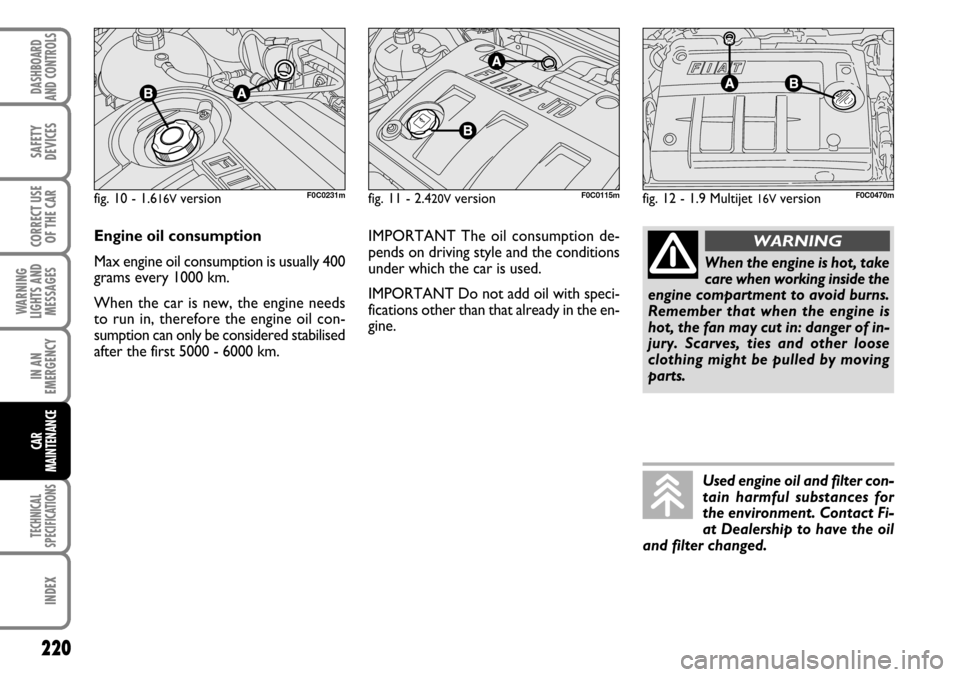
220
WARNING
LIGHTS AND
MESSAGES
TECHNICAL
SPECIFICATIONS
INDEX
DASHBOARD
AND CONTROLS
SAFETY
DEVICES
CORRECT USE
OF THE CAR
IN AN
EMERGENCY
CAR
MAINTENANCE
fig. 10 - 1.616V version F0C0231mfig. 11 - 2.420V version F0C0115mfig. 12 - 1.9 Multijet 16V version F0C0470m
Engine oil consumption
Max engine oil consumption is usually 400
grams every 1000 km.
When the car is new, the engine needs
to run in, therefore the engine oil con-
sumption can only be considered stabilised
after the first 5000 - 6000 km.IMPORTANT The oil consumption de-
pends on driving style and the conditions
under which the car is used.
IMPORTANT Do not add oil with speci-
fications other than that already in the en-
gine.
When the engine is hot, take
care when working inside the
engine compartment to avoid burns.
Remember that when the engine is
hot, the fan may cut in: danger of in-
jury. Scarves, ties and other loose
clothing might be pulled by moving
parts.
WARNING
Used engine oil and filter con-
tain harmful substances for
the environment. Contact Fi-
at Dealership to have the oil
and filter changed.
Page 222 of 274
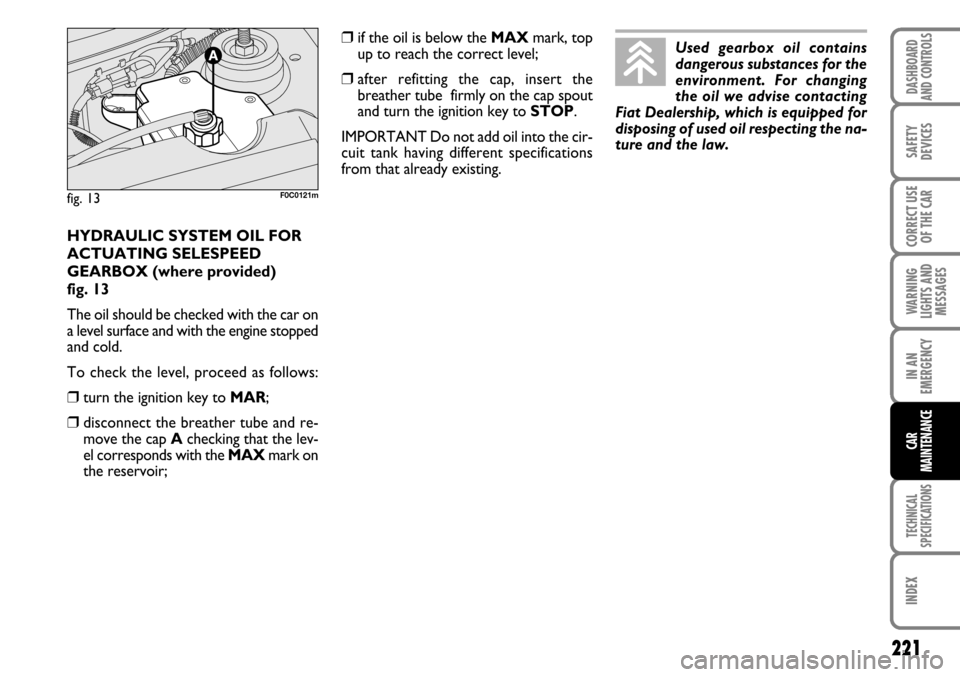
221
WARNING
LIGHTS AND
MESSAGES
TECHNICAL
SPECIFICATIONS
INDEX
DASHBOARD
AND CONTROLS
SAFETY
DEVICES
CORRECT USE
OF THE CAR
IN AN
EMERGENCY
CAR
MAINTENANCE
❒if the oil is below the MAXmark, top
up to reach the correct level;
❒after refitting the cap, insert the
breather tube firmly on the cap spout
and turn the ignition key to STOP.
IMPORTANT Do not add oil into the cir-
cuit tank having different specifications
from that already existing.
fig. 13F0C0121m
Used gearbox oil contains
dangerous substances for the
environment. For changing
the oil we advise contacting
Fiat Dealership, which is equipped for
disposing of used oil respecting the na-
ture and the law.
HYDRAULIC SYSTEM OIL FOR
ACTUATING SELESPEED
GEARBOX (where provided)
fig. 13
The oil should be checked with the car on
a level surface and with the engine stopped
and cold.
To check the level, proceed as follows:
❒turn the ignition key to MAR;
❒disconnect the breather tube and re-
move the cap Achecking that the lev-
el corresponds with the MAXmark on
the reservoir;
Page 223 of 274
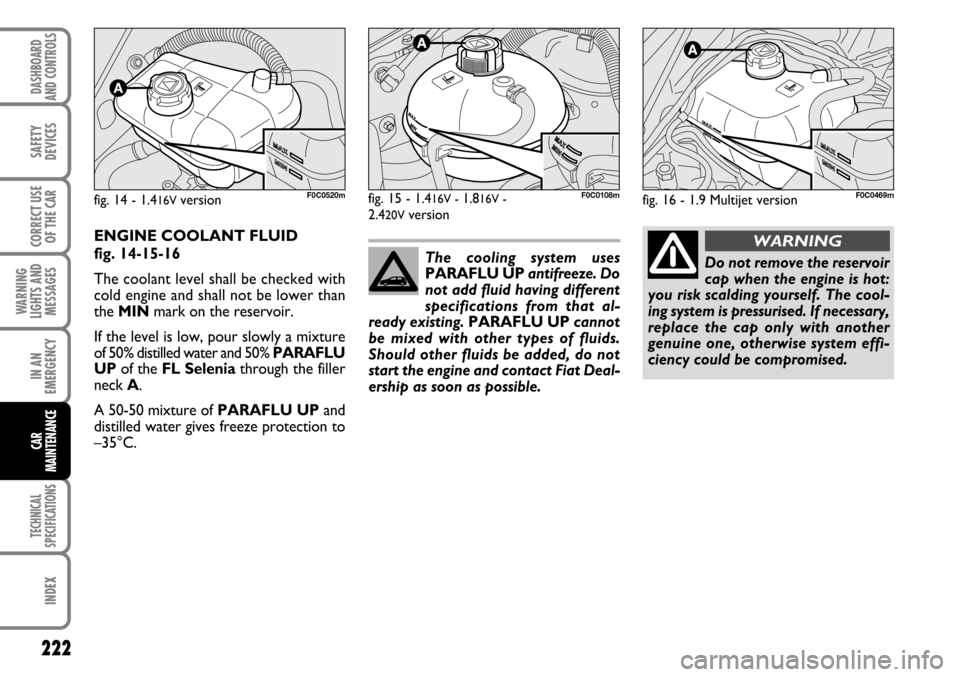
222
WARNING
LIGHTS AND
MESSAGES
TECHNICAL
SPECIFICATIONS
INDEX
DASHBOARD
AND CONTROLS
SAFETY
DEVICES
CORRECT USE
OF THE CAR
IN AN
EMERGENCY
CAR
MAINTENANCE
ENGINE COOLANT FLUID
fig. 14-15-16
The coolant level shall be checked with
cold engine and shall not be lower than
the MINmark on the reservoir.
If the level is low, pour slowly a mixture
of 50% distilled water and 50% PARAFLU
UPof the FL Seleniathroughthe filler
neck A.
A 50-50 mixture of PARAFLU UPand
distilled water gives freeze protection to
–35°C.
fig. 14 - 1.416V version F0C0520mfig. 15 - 1.416V - 1.816V - 2.420V version
F0C0108mfig. 16 - 1.9 Multijet version F0C0469m
The cooling system uses
PARAFLU UPantifreeze. Do
not add fluid having different
specifications from that al-
ready existing. PARAFLU UPcannot
be mixed with other types of fluids.
Should other fluids be added, do not
start the engine and contact Fiat Deal-
ership as soon as possible.Do not remove the reservoir
cap when the engine is hot:
you risk scalding yourself. The cool-
ing system is pressurised. If necessary,
replace the cap only with another
genuine one, otherwise system effi-
ciency could be compromised.
WARNING
Page 224 of 274
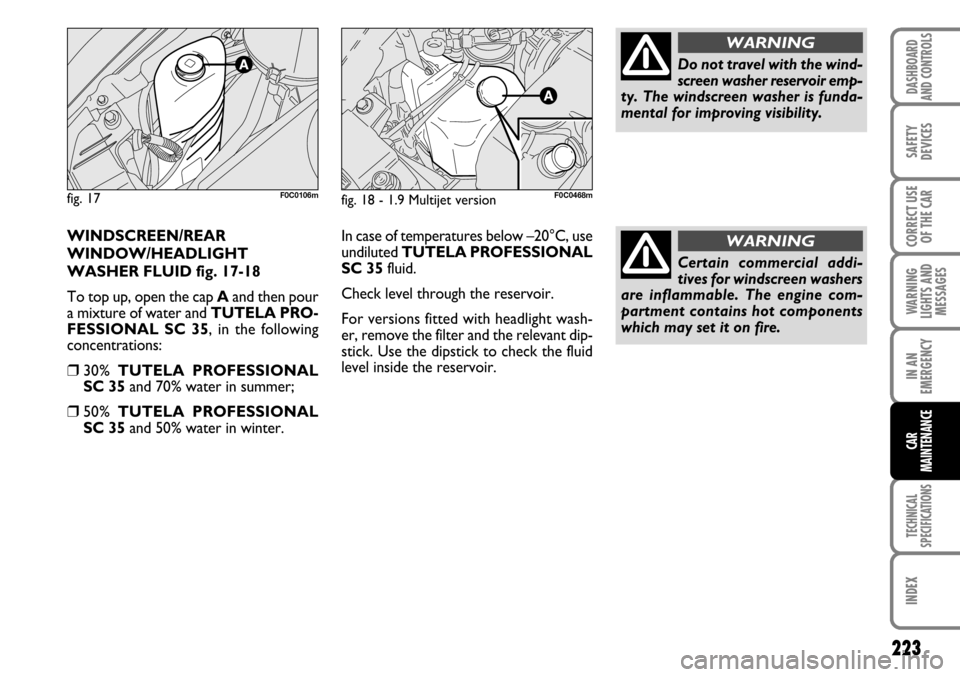
223
WARNING
LIGHTS AND
MESSAGES
TECHNICAL
SPECIFICATIONS
INDEX
DASHBOARD
AND CONTROLS
SAFETY
DEVICES
CORRECT USE
OF THE CAR
IN AN
EMERGENCY
CAR
MAINTENANCE
WINDSCREEN/REAR
WINDOW/HEADLIGHT
WASHER FLUID fig. 17-18
To top up, open the cap Aand then pour
a mixture of water and TUTELA PRO-
FESSIONAL SC 35, in the following
concentrations:
❒30% TUTELA PROFESSIONAL
SC 35and 70% water in summer;
❒50% TUTELA PROFESSIONAL
SC 35and 50% water in winter.
fig. 17F0C0106mfig. 18 - 1.9 Multijet version F0C0468m
Do not travel with the wind-
screen washer reservoir emp-
ty. The windscreen washer is funda-
mental for improving visibility.
WARNING
Certain commercial addi-
tives for windscreen washers
are inflammable. The engine com-
partment contains hot components
which may set it on fire.
WARNINGIn case of temperatures below –20°C, use
undiluted TUTELA PROFESSIONAL
SC 35 fluid.
Check level through the reservoir.
For versions fitted with headlight wash-
er, remove the filter and the relevant dip-
stick. Use the dipstick to check the fluid
level inside the reservoir.
Page 228 of 274
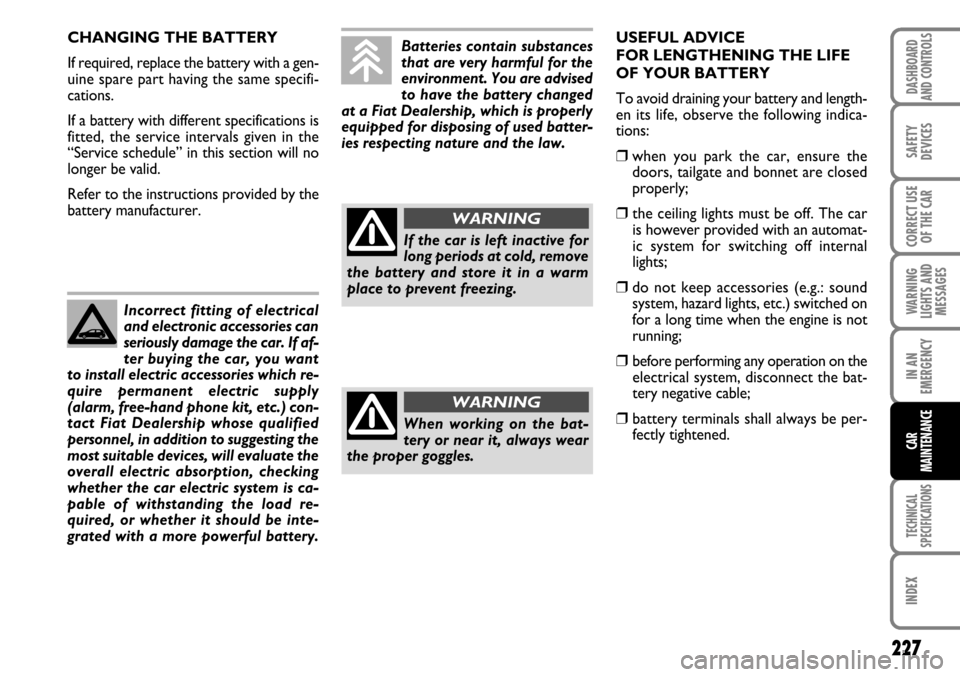
227
WARNING
LIGHTS AND
MESSAGES
TECHNICAL
SPECIFICATIONS
INDEX
DASHBOARD
AND CONTROLS
SAFETY
DEVICES
CORRECT USE
OF THE CAR
IN AN
EMERGENCY
CAR
MAINTENANCE
CHANGING THE BATTERY
If required, replace the battery with a gen-
uine spare part having the same specifi-
cations.
If a battery with different specifications is
fitted, the service intervals given in the
“Service schedule” in this section will no
longer be valid.
Refer to the instructions provided by the
battery manufacturer.
Incorrect fitting of electrical
and electronic accessories can
seriously damage the car. If af-
ter buying the car, you want
to install electric accessories which re-
quire permanent electric supply
(alarm, free-hand phone kit, etc.) con-
tact Fiat Dealership whose qualified
personnel, in addition to suggesting the
most suitable devices, will evaluate the
overall electric absorption, checking
whether the car electric system is ca-
pable of withstanding the load re-
quired, or whether it should be inte-
grated with a more powerful battery.USEFUL ADVICE
FOR LENGTHENING THE LIFE
OF YOUR BATTERY
To avoid draining your battery and length-
en its life, observe the following indica-
tions:
❒when you park the car, ensure the
doors, tailgate and bonnet are closed
properly;
❒ the ceiling lights must be off. The car
is however provided with an automat-
ic system for switching off internal
lights;
❒do not keep accessories (e.g.: sound
system, hazard lights, etc.) switched on
for a long time when the engine is not
running;
❒ before performing any operation on the
electrical system, disconnect the bat-
tery negative cable;
❒ battery terminals shall always be per-
fectly tightened. Batteries contain substances
that are very harmful for the
environment. You are advised
to have the battery changed
at a Fiat Dealership, which is properly
equipped for disposing of used batter-
ies respecting nature and the law.
If the car is left inactive for
long periods at cold, remove
the battery and store it in a warm
place to prevent freezing.
WARNING
When working on the bat-
tery or near it, always wear
the proper goggles.
WARNING
Page 234 of 274

233
WARNING
LIGHTS AND
MESSAGES
TECHNICAL
SPECIFICATIONS
INDEX
DASHBOARD
AND CONTROLS
SAFETY
DEVICES
CORRECT USE
OF THE CAR
IN AN
EMERGENCY
CAR
MAINTENANCE
BODYWORK
PROTECTION FROM
ATMOSPHERIC AGENTS
The main causes of corrosion are the fol-
lowing:
❒atmospheric pollution;
❒salty air and humidity (coastal areas, or
hot humid climates);
❒ seasonal environment conditions.
Not to be underestimated is also the abra-
sive action of wind-borne atmospheric
dust and sand and mud and gravel raised
by other cars.
On your car, Fiat implemented the best
manufacturing technologies to effectively
protect the bodywork against corrosion.These include:
❒ Painting products and systems which
give the car particular resistance to cor-
rosion and abrasion;
❒Use of galvanised (or pretreated) steel
sheets, with high resistance to corro-
sion;
❒Spraying the underbody, engine com-
partment, wheelhouse internal parts
and other parts with highly protective
wax products;
❒Spraying of plastic parts, with a protec-
tive function, in the more exposed
points: underdoor, inner fender parts,
edges, etc.;
❒Use of “open” boxed sections to pre-
vent condensation and pockets of mois-
ture from triggering rust inside.
BODY AND UNDERBODY
WARRANTY
Your car is covered by warranty against
perforation due to rust of any original el-
ement of the structure or body. For the
general terms of this warranty, refer to
the Fiat Warranty booklet.ADVICE FOR PRESERVING
THE BODYWORK
Paint
Paintwork does not only serve an aesteth-
ic purpose, but also protects the under-
lying sheet metal.
In the case of deep scrapes or scores, you
are advised to have the necessary touch-
ing up carried out immediately to avoid
the formation of rust. Use only original
paint products for touching up (see “Body-
work paint identification plate” in section
“Technical specification”).
Normal paint maintenance consists in
washing at intervals depending on the con-
ditions and environment of use. For ex-
ample, in highly polluted areas, or if the
roads are sprayed with salt, it is wise to
wash the car more frequently.
Page 235 of 274
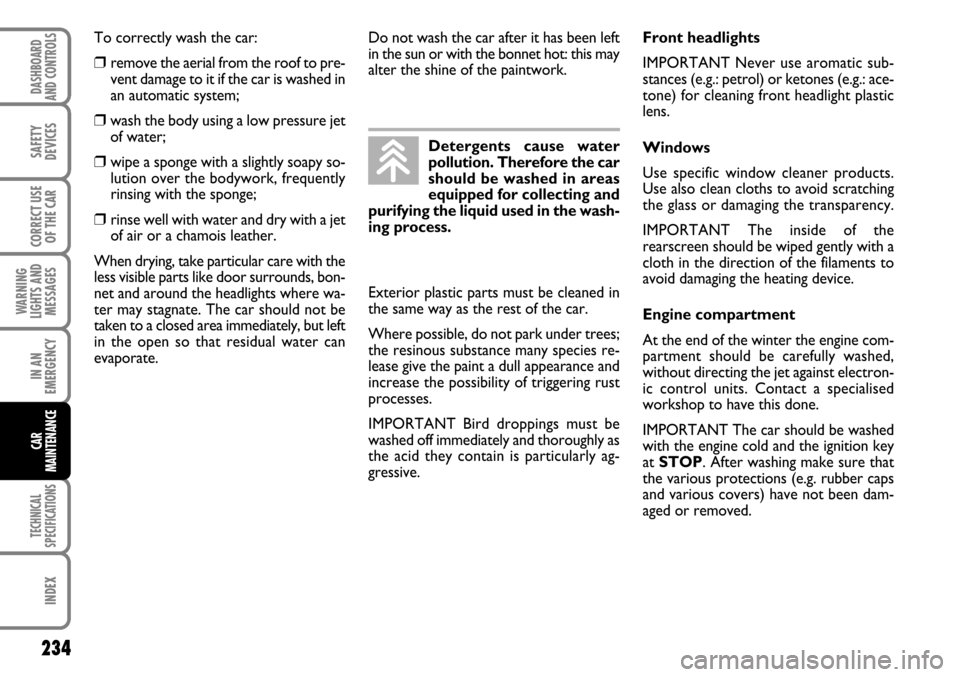
234
WARNING
LIGHTS AND
MESSAGES
TECHNICAL
SPECIFICATIONS
INDEX
DASHBOARD
AND CONTROLS
SAFETY
DEVICES
CORRECT USE
OF THE CAR
IN AN
EMERGENCY
CAR
MAINTENANCE
To correctly wash the car:
❒ remove the aerial from the roof to pre-
vent damage to it if the car is washed in
an automatic system;
❒wash the body using a low pressure jet
of water;
❒ wipe a sponge with a slightly soapy so-
lution over the bodywork, frequently
rinsing with the sponge;
❒ rinse well with water and dry with a jet
of air or a chamois leather.
When drying, take particular care with the
less visible parts like door surrounds, bon-
net and around the headlights where wa-
ter may stagnate. The car should not be
taken to a closed area immediately, but left
in the open so that residual water can
evaporate.Exterior plastic parts must be cleaned in
the same way as the rest of the car.
Where possible, do not park under trees;
the resinous substance many species re-
lease give the paint a dull appearance and
increase the possibility of triggering rust
processes.
IMPORTANT Bird droppings must be
washed off immediately and thoroughly as
the acid they contain is particularly ag-
gressive.Front headlights
IMPORTANT Never use aromatic sub-
stances (e.g.: petrol) or ketones (e.g.: ace-
tone) for cleaning front headlight plastic
lens.
Windows
Use specific window cleaner products.
Use also clean cloths to avoid scratching
the glass or damaging the transparency.
IMPORTANT The inside of the
rearscreen should be wiped gently with a
cloth in the direction of the filaments to
avoid damaging the heating device.
Engine compartment
At the end of the winter the engine com-
partment should be carefully washed,
without directing the jet against electron-
ic control units. Contact a specialised
workshop to have this done.
IMPORTANT The car should be washed
with the engine cold and the ignition key
at STOP. After washing make sure that
the various protections (e.g. rubber caps
and various covers) have not been dam-
aged or removed. Detergents cause water
pollution. Therefore the car
should be washed in areas
equipped for collecting and
purifying the liquid used in the wash-
ing process.
Do not wash the car after it has been left
in the sun or with the bonnet hot: this may
alter the shine of the paintwork.
Page 238 of 274
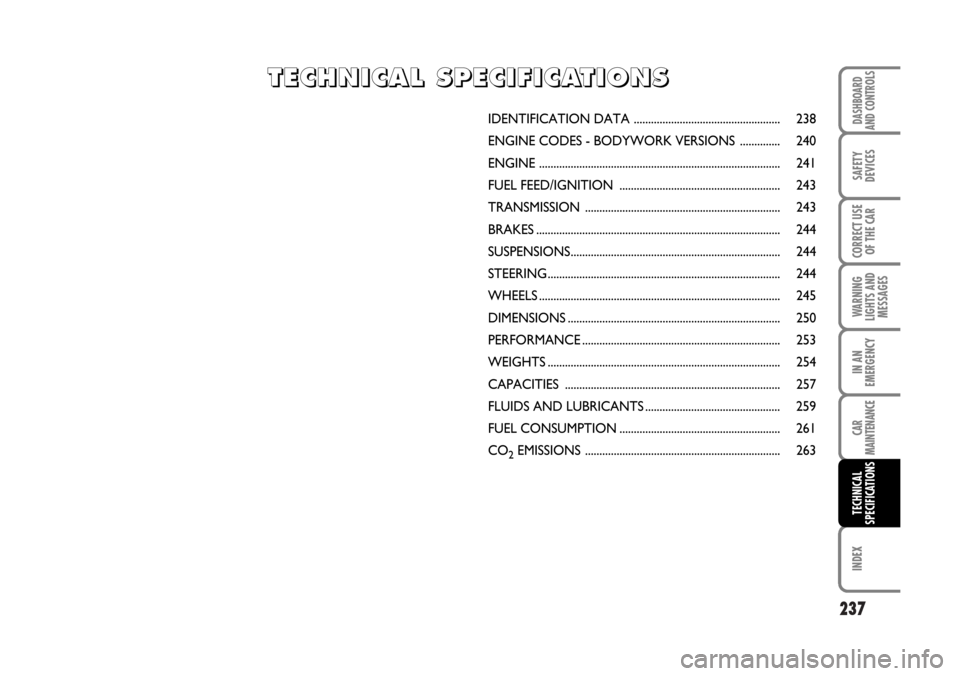
237
WARNING
LIGHTS AND
MESSAGES
INDEX
DASHBOARD
AND CONTROLS
SAFETY
DEVICES
CORRECT USE
OF THE CAR
IN AN
EMERGENCY
CAR
MAINTENANCE
TECHNICAL
SPECIFICATIONS
IDENTIFICATION DATA ................................................... 238
ENGINE CODES - BODYWORK VERSIONS .............. 240
ENGINE .................................................................................... 241
FUEL FEED/IGNITION ........................................................ 243
TRANSMISSION .................................................................... 243
BRAKES ..................................................................................... 244
SUSPENSIONS......................................................................... 244
STEERING ................................................................................. 244
WHEELS .................................................................................... 245
DIMENSIONS .......................................................................... 250
PERFORMANCE ..................................................................... 253
WEIGHTS ................................................................................. 254
CAPACITIES ........................................................................... 257
FLUIDS AND LUBRICANTS ............................................... 259
FUEL CONSUMPTION ........................................................ 261
CO
2EMISSIONS .................................................................... 263
T T
E E
C C
H H
N N
I I
C C
A A
L L
S S
P P
E E
C C
I I
F F
I I
C C
A A
T T
I I
O O
N N
S S
Page 239 of 274
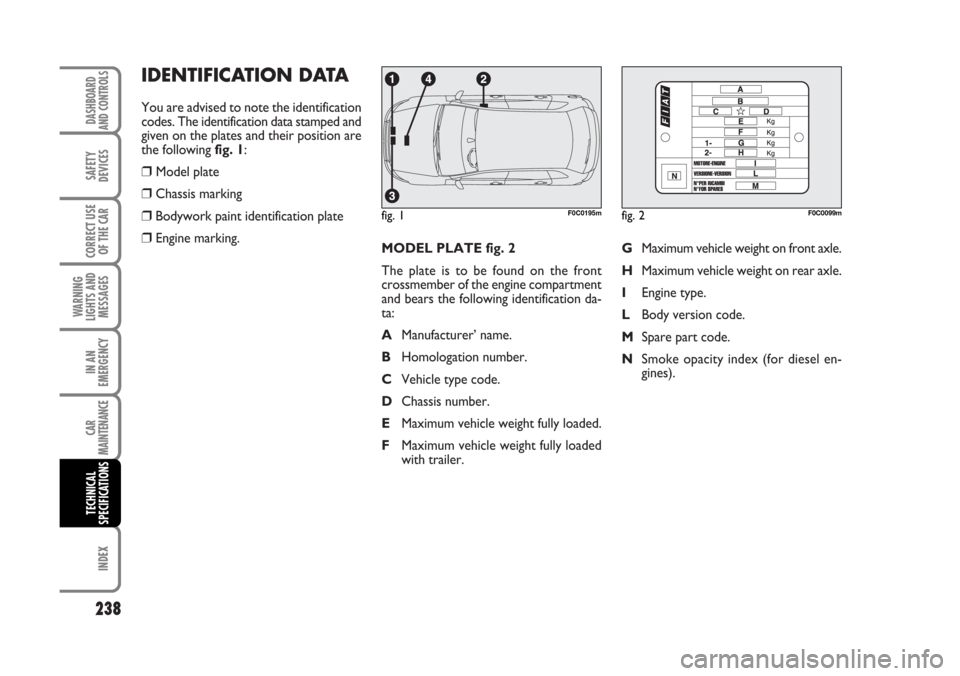
MODEL PLATE fig. 2
The plate is to be found on the front
crossmember of the engine compartment
and bears the following identification da-
ta:
AManufacturer’ name.
BHomologation number.
CVehicle type code.
DChassis number.
EMaximum vehicle weight fully loaded.
FMaximum vehicle weight fully loaded
with trailer.GMaximum vehicle weight on front axle.
HMaximum vehicle weight on rear axle.
IEngine type.
LBody version code.
MSpare part code.
NSmoke opacity index (for diesel en-
gines).
IDENTIFICATION DATA
You are advised to note the identification
codes. The identification data stamped and
given on the plates and their position are
the following fig. 1:
❒ Model plate
❒Chassis marking
❒Bodywork paint identification plate
❒Engine marking.
238
WARNING
LIGHTS AND
MESSAGES
INDEX
DASHBOARD
AND CONTROLS
SAFETY
DEVICES
CORRECT USE
OF THE CAR
IN AN
EMERGENCY
CAR
MAINTENANCE
TECHNICAL
SPECIFICATIONS
fig. 1F0C0195mfig. 2F0C0099m
Page 240 of 274
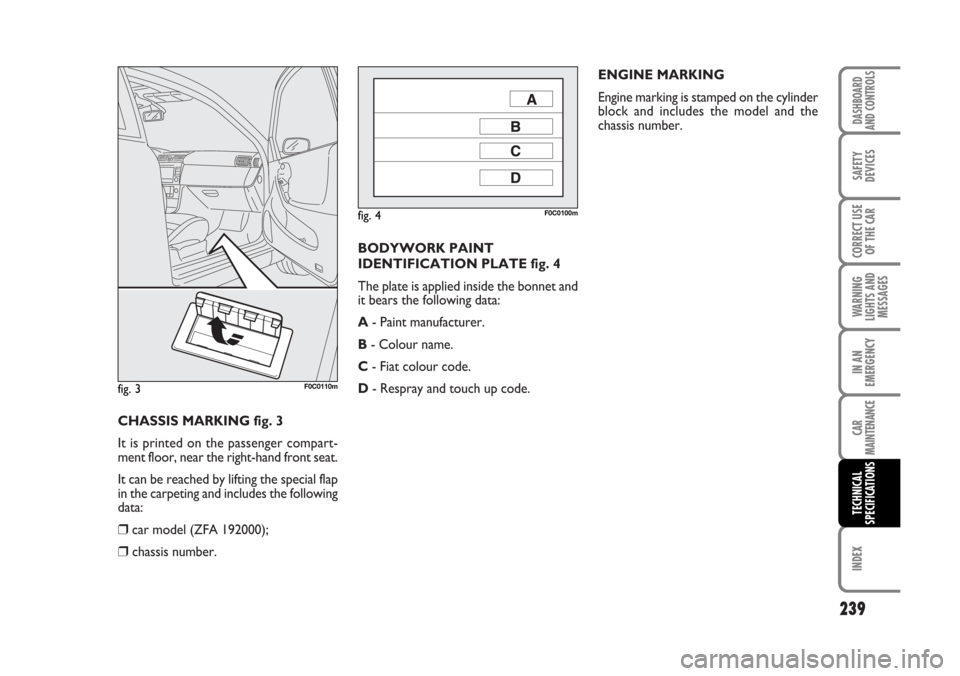
BODYWORK PAINT
IDENTIFICATION PLATE fig. 4
The plate is applied inside the bonnet and
it bears the following data:
A- Paint manufacturer.
B- Colour name.
C- Fiat colour code.
D- Respray and touch up code.ENGINE MARKING
Engine marking is stamped on the cylinder
block and includes the model and the
chassis number.
CHASSIS MARKING fig. 3
It is printed on the passenger compart-
ment floor, near the right-hand front seat.
It can be reached by lifting the special flap
in the carpeting and includes the following
data:
❒car model (ZFA 192000);
❒ chassis number.
239
WARNING
LIGHTS AND
MESSAGES
INDEX
DASHBOARD
AND CONTROLS
SAFETY
DEVICES
CORRECT USE
OF THE CAR
IN AN
EMERGENCY
CAR
MAINTENANCE
TECHNICAL
SPECIFICATIONS
fig. 4F0C0100m
fig. 3F0C0110m